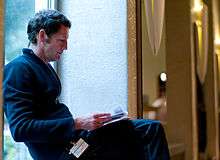Joachim Sauter

Joachim Sauter (born 1959) is a German media artist and designer. He was appointed Professor for New Media Art and Design at the Universität der Künste Berlin, UdK (Berlin University of the Arts) in 1991.[1]
Biography
Sauter studied design at the UdK Berlin, and studied direction and camera at the German Academy for Film and Television, Berlin. He has been using computers both as a tool and as a medium since the early stages of his work.[2] A pioneer of new media, he has developed and shaped this field with his works from the early 1980s on.
In 1988 he founded the new media design studio ART+COM, together with other designers, architects, technologists, and their ilk - more generally, artists and scientists. Their goal was to practically research this new upcoming medium in the realm of art and design.[3] They have come to emphasize the translation of information (easily transmissible via new media) into physical spaces, offering a more communal, reality-grounded experience than computer monitors alone allow for.[4]
Joachim Sauter lives and works in Berlin.
Projects with ART+COM (partial)
Art:
- 2013 "Symphonie Cinétique - The Poetry of Motion" – exhibition and performance in collaboration with Ólafur Arnalds
- 2013 "Ink Drops to the Origin" — interactive installation
- 2012 "Kinetic Rain" – kinetic installation
- 2008 "Kinetic Sculpture" – kinetic sculpture
- 2007 "Duality" – interactive environmental installation, Tokyo
- 2002 "Behind the Lines" - interactive installation
- 1999-2002 "The Jew of Malta" – medial stage
- 1995-now "The Invisible Shapes of Things Past" – architectural sculptures made of films
- 1992 "De-Viewer" – interactive installation
Design:
- 2008 "Spheres" – mediatecture
- 2005 "documenta mobil" – mobile exhibition
- 2004 "floating.numbers" – interactive table installation
- 2004 "Austrian Flag" - interactive flag
- 1996 "Terravision" – interactive installation
- 1995-now "timescope" - low-tech augmented reality device
Exhibitions (partial)
- 2013 "LeBains", Paris, France
- 2011 "Matter Light II", Borusan Center for Culture and Arts, Istanbul, Turkey
- 2010 "moving spaces", Alva Aalto Museum, Aalborg, Denmark
- 2008 "on cities", National Architecture Museum Stockholm, Sweden
- 2007 “From Sparc to Pixel”, Martin Gropius Bau, Berlin, Germany
- 2006 “Venice Biennale of Architecture”, German Pavilion, Italy
- 2006 “Shanghai Biennale", China
- 2006 “Digital Transit”, ARCO, Madrid, Spain
- 2005 "São Paulo Biennale of Architecture", Brasil
- 2004 “Navigator”, National Museum of Fine Arts, Taichung, Taiwan
- 2003 “Future Cinema”, ZKM, Karlsruhe, Germany/Lille, France
- 2001 “Invisible”, Museum of Contemporary Art, Porto, Portugal
- 1998 “Portable Sacred Grounds”, ICC, Tokyo, Japan
- 1996 “Wunschmaschine, Welterfindung”, Kunsthalle Wien, Austria
- 1996 “Under the Capricorn”, Steijdilik Museum, Amsterdam, Netherlands
- 1995 “Anew Europe”, Venice Biennale, Italy
- 1993 “Artec”, Museum of Modern Art, Nagoya, Japan
- 1992 “Manifeste”, Centre Pompidou, Paris, France
See also
References
- ↑ "Gestalten mit digitalen Medien". Universität der Künste Berlin. Retrieved 20 November 2010.
- ↑ "Colloquium: Joachim Sauter, "The Renaissance of Space"". MIT Media Lab. April 5, 2010. Retrieved 20 November 2010.
- ↑ "Staff". ART+COM -. Retrieved 20 November 2010.
- ↑ "The Creators Project | Joachim Sauter". The Creators Project -. Retrieved 7 November 2012.
External links
| Wikimedia Commons has media related to Joachim Sauter. |